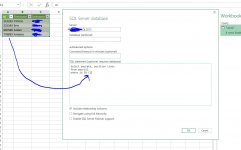This may be a tricky one - I have a need when creating a sql statement "from database" in the PowerQuery ribbon. I have a query in PowerQuery from a flat file, it has a few hundred persons records with a unique ID. I want to bring in corresponding salary information (and perhaps other info) for these persons into the data model I'm attempting from a SQL server, however, the table contains 600,000 + records; I dont want them all for this application and would like to limit records to the few hundred distinct person ID's from my flat file. Is there a way to refer to the unique ID's in the WHERE clause of the SQL Statement field (via Excel 2013 PowerQuery > From Database > From SQL Server Database > Advanced Options > SQL Statement ) ? I'm trying to find a smarter way than just copying the unique ID's, adding commas and parenthesizes and pasting into the query window. This use pattern will come up again.
I have ken plus's book M is for Monkey but I am unable to find this sort of issue or an example in the book. Below is a micro example of what Im attempting. Thank you all in advance

I have ken plus's book M is for Monkey but I am unable to find this sort of issue or an example in the book. Below is a micro example of what Im attempting. Thank you all in advance


